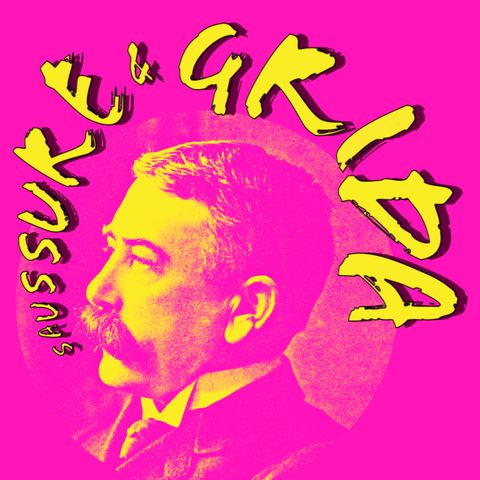15. Come si impara un'altra lingua? Di interlingua, emisferi e giochi

Descarga y escucha en cualquier lugar
Descarga tus episodios favoritos y disfrútalos, ¡dondequiera que estés! Regístrate o inicia sesión ahora para acceder a la escucha sin conexión.
Descripción
In questa puntata vediamo il processo di apprendimento linguistico e le teorie che lo circondano. Parliamo di interlingua, un concetto chiave nello studio dell'acquisizione, e di emisferi cerebrali e di...
mostra másGrafiche: Gianluca La Bruna
La sigla è stata prodotta da White Hot e fornita da https://freebeats.io
Fonti:
- Beaumont, J.G. (2008). "Chapter 7". Introduction to Neuropsychology (Second ed.). The Guilford Press.
- Burghardt, G.M. (2005). The genesis of animal play: Testing the limits. Cambridge, MA: MIT Press.
- Cai, Q., Haegen, L., & Brysbaert, M. (2013). Complementary hemispheric specialization for language production and visuospatial attention. Proceedings of the National Academy of Sciences of the United States of America, 110(4):1158-1159.
- Clahsen, H., & Felser, C. (2006). Grammatical processing in language learners. Applied Psycholinguistics, 27(1):3–42.
- Chini, M. (2001). Che cos'è la linguistica acquisizionale. Roma: Carocci.
- Cohen, A.D. (1982). Neurolinguistics and second language acquisition. TESOL Quarterly, 16(3):305-306.
- Congmin, Z. (2022). Hemispheric Lateralization and Language Learning: Neurolinguisitc Considerations. Sino-US English Teaching, 19(6)204-208.
- Ellis, R. (2005). Measuring implicit and explicit knowledge of a second language: A psychometric study. Studies in Second Language Acquisition. 27(2):141–172
- Fodor, J. (1980). Fixation of belief and concept acquisition. In M. Piattelli-Palmarini (Ed.), Language and learning: The debate between Jean Piaget and Noam Chomsky. Cambridge, MA: Harvard University Press.
- Han, Z.H.; Baohan, A. (2023). Age and attainment in foreign language learning: The critical period account stands. Brain and Language 246:105-343.
- Kilgard, M.P. (1998). "Plasticity of temporal information processing in the primary auditory cortex". Nature Neuroscience. 1(8):727–731.
- Lantolf, J.P., & Beckett, T.G. (2009). Sociocultural theory and second language acquisition. Language Teaching. 42(4):459–475.
- Lenneberg, E.H. (1967). Biological Foundations of Language. New York: Wiley.
- Loewen, S., & Reinders, H. (2011). Key concepts in second language acquisition. Houndmills, Basingstoke, Hampshire: Palgrave Macmillan.
- Nebes, R.D. (1978). Direct examination of cognitive functions in the right and left hemispheres. In M. Kinsbourne (Ed.), Asymmetrical functions of the brain. New York: Cambridge UP.
- Pellegrini, A.D., Dupuis, D., & Smith, P.K. (2007). Play in evolution and development. Developmental Review, 27(2):261–276.
- Pienemann, M. (1998). Language processing and second language development: Processability theory. Amsterdam: John Benjamins.
- Ramscar, M., & Gitcho, N. (2007). Developmental change and the nature of learning in childhood. Trends in Cognitive Sciences. 11(7):274–279.
- Rastelli, S. (2018). Neurolinguistics and second language teaching: A view from the crossroads. Second Language Research, 34(1), 103–123.
- Reinders, H. (2011). Key concepts in second language acquisition. Houndmills, Basingstoke, Hampshire: Palgrave Macmillan.
- Riès, S.K.; Dronkers, N.F.; Knight, R.T. (2016). Choosing words: left hemisphere, right hemisphere, or both? Perspective on the lateralization of word retrieval. Annals of the New York Academy of Sciences. 1369(1):111–131.
- Rogers, L.J. (2021). Brain Lateralization and Cognitive Capacity. Animals. 11(7):1996.
- Seliger, H.W. (1982). On the possible role of the right hemisphere in second language acquisition. TESOL Quarterly, 16(3):307-314.
- Schmidt, R. (1990). The role of consciousness in second language learning. Applied Linguistics, 11(2):129–158.
- Schmidt, R. (2002). Interaction hypothesis. In J. Richards & R. Schmidt (Eds.). Longman dictionary of language teaching and applied linguistics. London New York: Longman.
- Singleton, D., & Lengyel, Z. (Eds.) (1995). The age factor in second language acquisition: a critical look at the critical period hypothesis. Clevedon, UK: Philadelphia.
- Snow, C.E., & Hoefnagel-Hohle, M. (1978). The Critical Period for Language Acquisition: Evidence from Second Language Learning. Child Development. 49(4):1114-1128.
- Taylor I., & Taylor, M.M. (1990). Psycholinguistics: Learning and using Language. Pearson.
- Tarone, E. (2001). Interlanguage. In R. Mesthrie (Ed.). Concise Encyclopedia of Sociolinguistics. (475–481) Oxford: Elsevier Science.
- Thompson, R. A. (1984). Language, the brain, and the question of dichotomies. American Anthropologist, New Series, 86(1):98-105.
- Walker, L.C. (1981). The Ontogeny of the Neural Substrate for Language. Journal of Human Evolution 10(5):429–441.
Información
| Autor | Irene |
| Organización | Irene Lami |
| Página web | - |
| Etiquetas |
Copyright 2024 - Spreaker Inc. an iHeartMedia Company
